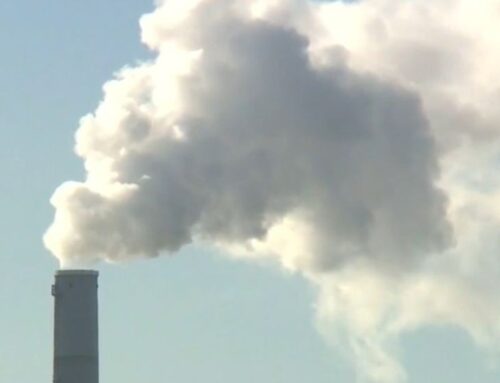How Clean Energy Just Overtook Coal — And Why It’s Under Threat
October 9, 2025
For the first time in history, renewables have generated more electricity than coal globally. But as science powers this breakthrough, it’s come under attack — and in a twist few saw coming, the Vatican is defending it.
Clean energy has just made history — generating more electricity than coal for the first time ever. According to Ember’s Global Electricity Mid-Year Insights 2025, renewables supplied 34.3 percent of global electricity in the first half of 2025, overtaking coal’s 33.1 percent share — a moment that marks the beginning of the end for the fossil-fuel era.
But even as science achieves what once seemed impossible, political forces are moving to undermine it, waging a new war not on technology — but on truth itself. And in a twist few could have predicted, the Vatican has emerged as one of science’s strongest defenders — rallying global faith and moral authority behind the facts that denial seeks to erase.
A Historic Turning Point for Clean Power
The world has crossed a historic threshold;
- Solar output jumped 31 percent (+306 TWh) in early 2025, meeting 83 percent of global demand growth.
- Wind generation rose 7.7 percent (+97 TWh).
- Fossil generation declined 0.3 percent, even as overall demand increased 2.6 percent.
China met its entire electricity demand growth with clean sources, cutting emissions 1.7 percent (–46 Mt CO₂). India’s surge in solar and wind reduced emissions 3.6 percent (–24 Mt CO₂).
In the European Union, renewables surpassed all fossil fuels combined for electricity generation last year — a world first. In the United States, an extraordinary 96 percent of new power capacity added in 2024 was fossil-free.
Meanwhile, clean technologies are scaling at eye-watering speed. According to the IEA, global EV sales were up 35% year-on-year in the first three months of 2025, marking another exponential leap toward a fossil-free transport system. Battery energy storage systems are also booming: in the U.S. alone, planned additions in 2024 could nearly double capacity, and global deployments grew 53 % over the prior year. Within a decade, many new vehicles and power grids may largely bypass fossil fuels — instead drawing directly from wind, solar, and storage.
“Clean power is now growing fast enough to meet the world’s appetite for electricity,… This marks the beginning of a structural transition.”
The Science Worked. The Backlash Began.
Yet as the data delivers hope, science itself is under assault.
The Union of Concerned Scientists report from July 2025 documented 402 attacks on science during the Trump administration’s first six months back in power — the fastest erosion of federal scientific capacity in U.S. history.
Within weeks, the administration launched an all-out assault on climate research: NASA’s CO₂-monitoring satellites were ordered by the White House to terminated, the Mauna Loa Observatory is under threat to be shut down, and the EPA’s endangerment finding — its legal basis for regulating emissions — is about to be revoked. NOAA’s climate division was dismantled, USDA climate data erased, 1,100 EPA scientist positions cut, and plans are underway to cancel the $7 billion Solar for All program.
“You can’t manage what you can’t measure,” one NASA scientist told Reuters. “Eliminating the data eliminates accountability.”
The Anti-Science Movement Goes Global
And it’s spreading.
Eurostat
- In Sweden, Finance Minister Elisabeth Svantesson went on national television to claim that Sweden has “the world’s lowest carbon footprint.” Scientists quickly pointed out the opposite: while most EU nations are cutting emissions, Sweden’s are rising faster than any other. The European Commission has now referred Sweden to the EU Court of Justice for failing to implement new renewable-energy permitting rules — a breach that could trigger financial penalties. When governments ignore evidence, lie about the facts and delay clean-energy progress, it’s not just climate policy at risk — it’s science itself.
- In Germany, the AfD — now polling as the country’s largest party — has pledged to tear down wind turbines and roll back clean-energy goals.
- In the United Kingdom, the Conservative opposition is trying to win the election by scrapping the country’s science-based climate targets.
- In Australia, fossil-fuel lobbying and media disinformation — backed by over $1 billion a year globally, according to Global Witness — have slowed climate policy even as the country records its hottest years on record.
- Globally, the five largest oil majors have spent over $1 billion since the Paris Agreement on lobbying and branding that undermine international climate goals.
Across continents, populist movements are reframing climate action as elitist ideology — the same playbook once used against vaccines and public health. Their goal is simple: protect fossil profits by eroding public trust in science.
But truth has a strange resilience — the harder it’s attacked, the stronger it often becomes.
Signs of Hope and Resilience
Even amid the backlash, progress continues to accelerate across the world. From California and New York to capitals across the European Union, governments are doubling down on 100 percent clean-power mandates. China and India are pouring record investments into solar, battery storage, and electric mobility — reshaping the world’s industrial backbone in real time. Corporate appetite is soaring too: companies signed more than 90 gigawatts of clean power purchase agreements in 2024, the highest ever recorded. And according to the International Energy Agency, global clean-energy investment will reach $2 trillion in 2025, outpacing fossil fuels by a factor of two to one.
For investors, this is not ideology — it’s market momentum. Renewables are outperforming the S&P 500, and clean-tech equities are driving a new industrial wave built on electrons, not oil.
When Faith Defended Science
As political attacks on science intensify, an unlikely defender has stepped forward: the Vatican.
In October, Pope Leo XIV—widely viewed as more conservative than his predecessor, Pope Francis—surprised the world by inviting scientists, activists, and political leaders to his private summer residence at Castel Gandolfo. I was there and his message was unmistakable: faith and science are not enemies, but allies in truth.
At the Raising Hope for Climate Justice gathering, the Pope called on global citizens to reject the manipulation of facts and to stand firm behind evidence and reason.
“Some have chosen to deride the increasingly evident signs of climate change, to ridicule those who speak of global warming, and even to blame the poor for the very thing that affects them the most,… There is no room for indifference or resignation.”
One of his first actions as the new Pope was to ensure that the Vatican becomes one of the world’s first states powered entirely by clean energy — expanding the solar transition begun under Francis with a vast new solar farm at Santa Maria Galeria, designed to meet all of the Holy See’s electricity needs.
Two headlines told the story of our divided times:
📰 Reuters: “Schwarzenegger at Vatican in mission to terminate fossil fuels.”
🗞️ Daily Mail: “Woke American Pope blesses a block of ice in bizarre climate change stunt.”
But inside Castel Gandolfo, the focus was clear: to defend the very foundation of truth. In an age when denial has become political currency, the Pope used his global platform to call for courage — to protect not just creation, but the credibility of knowledge itself.
And standing on the same stage was Arnold Schwarzenegger — a Republican, a lifelong conservative, and former governor of California — echoing the Pope’s message word for word.
“It’s time to say hasta la vista to the special interests standing in the way of climate action”
Together, they embodied what the world needs most: unity across old divisions — faith and reason, left and right — coming together to defend science itself.
With 1.3 billion members and 400,000 priests worldwide, the Catholic Church may now be the most powerful ally science has.
Below is a brief summary highlighting key moments from the Raising Hope for Climate Justice conference, which I attended and documented firsthand.
The Outlook: Clean Energy Is Unstoppable — But Delay Is Deadly
As the world moves toward COP30 in Belém, Brazil, one truth stands above the noise: the clean energy revolution rests on decades of public science, open data, and transparency. These institutions of truth are the quiet engines behind every solar breakthrough, every emissions target, every policy that works. If they erode, progress itself can still be undone.
Defending that infrastructure is no longer the job of scientists alone. It is an economic, moral, and civic imperative.
Leaders across business and government can help secure the transition by embracing science-based governance, channeling capital into climate solutions, and standing up for facts in the public sphere.
Clean energy has dethroned coal — a triumph of science over pollution.
That single milestone proves what once seemed impossible: the green transition is real, accelerating, and unstoppable.
But delay is deadly. Each year of hesitation locks in decades of damage — from melting ice sheets to collapsing ecosystems and rising human costs. The data shows hope, but the physics demands urgency. At COP30, world leaders hold the power to act — or the burden of failure.
History will remember not who believed in science, but who defended it when it mattered most.
Written by Ingmar Rentzhog, climate communicator and Founder & CEO of Wedonthavetime.org. Follow me on Forbes and LinkedIn for stories at the intersection of science, truth, and the clean-energy revolution.
Search
RECENT PRESS RELEASES
Related Post


